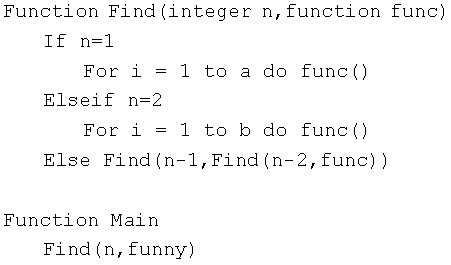Brute-force Algorithm(hdu3221)
Posted SJY
tags:
篇首语:本文由小常识网(cha138.com)小编为大家整理,主要介绍了Brute-force Algorithm(hdu3221)相关的知识,希望对你有一定的参考价值。
Brute-force Algorithm
Time Limit: 2000/1000 MS (Java/Others) Memory Limit: 32768/32768 K (Java/Others)
Total Submission(s): 2740 Accepted Submission(s): 728
Problem Description
Professor
Brute is not good at algorithm design. Once he was asked to solve a
path finding problem. He worked on it for several days and finally came
up with the following algorithm:

Any fool but Brute knows that the function “funny” will be called too many times. Brute wants to investigate the number of times the function will be called, but he is too lazy to do it.
Now your task is to calculate how many times the function “funny” will be called, for the given a, b and n. Because the answer may be too large, you should output the answer module by P.

Any fool but Brute knows that the function “funny” will be called too many times. Brute wants to investigate the number of times the function will be called, but he is too lazy to do it.
Now your task is to calculate how many times the function “funny” will be called, for the given a, b and n. Because the answer may be too large, you should output the answer module by P.
Input
There are multiple test cases. The first line of the input contains an integer T, meaning the number of the test cases.
For each test cases, there are four integers a, b, P and n in a single line.
You can assume that 1≤n≤1000000000, 1≤P≤1000000, 0≤a, b<1000000.
For each test cases, there are four integers a, b, P and n in a single line.
You can assume that 1≤n≤1000000000, 1≤P≤1000000, 0≤a, b<1000000.
Output
For each test case, output the answer with case number in a single line.
Sample Input
3
3 4 10 3
4 5 13 5
3 2 19 100
Sample Output
Case #1: 2
Case #2: 11
Case #3: 12
思路:a的指数和b的指数是斐波数列,所以按照指数来,然后当指数小于p时直接快速幂,否则矩阵快速幂,加上oula降幂,前面小于p直接快速幂,也保证了后面使用欧拉降幂的条件。
1 #include<stdio.h> 2 #include<algorithm> 3 #include<iostream> 4 #include<string.h> 5 #include<queue> 6 #include<set> 7 #include<math.h> 8 using namespace std; 9 typedef long long LL; 10 typedef struct node 11 { 12 LL m[4][4]; 13 node() 14 { 15 memset(m,0,sizeof(m)); 16 } 17 } maxtr; 18 int f1[1000]; 19 int f2[1000]; 20 maxtr E(); 21 void Init(maxtr *q); 22 maxtr quick_m(maxtr ans,LL n,LL mod); 23 LL quick(LL n,LL m,LL mod); 24 bool prime[1000005]; 25 int aa[1000005]; 26 int oula[1000005]; 27 28 int main(void) 29 { 30 int T; 31 int __ca = 0; 32 int i,j; 33 int k1,k2; 34 f1[2] = 0; 35 f1[3] = 1; 36 f2[2] = 1; 37 f2[3] = 1; 38 for(i = 2; i < 1000; i++) 39 { 40 for(j = i; (i*j) <= 1000000; j++) 41 { 42 prime[i*j] = true; 43 } 44 } 45 int cn = 0; 46 for(i = 2; i <= 1000000; i++) 47 { 48 oula[i] =i; 49 if(!prime[i]) 50 aa[cn++] = i; 51 } 52 for(i = 0; i < cn; i++) 53 { 54 for(j = 1; (j*aa[i])<=1000000; j++) 55 { 56 oula[j*aa[i]]/=aa[i]; 57 oula[j*aa[i]]*=(aa[i]-1); 58 } 59 } 60 for(i = 4;; i++) 61 { 62 f1[i] = f1[i-1]+f1[i-2]; 63 if(f1[i] > 1000000) 64 { 65 k1 = i; 66 break; 67 } 68 } 69 for(i = 4;; i++) 70 { 71 f2[i] = f2[i-1] + f2[i-2]; 72 if(f2[i] > 1000000) 73 { 74 k2 = i; 75 break; 76 } 77 } 78 k1=max(k1,k2); 79 scanf("%d",&T); 80 while(T--) 81 { 82 __ca++; 83 LL n,p,a,b; 84 scanf("%lld %lld %lld %lld",&a,&b,&p,&n); 85 printf("Case #%d: ",__ca); 86 if(n==1) 87 { 88 printf("%lld\n",a%p); 89 } 90 else if(n == 2) 91 { 92 printf("%lld\n",b%p); 93 } 94 else if(n == 3) 95 { 96 printf("%lld\n",a*b%p); 97 } 98 else if(n<=k1) 99 { 100 int x1 = f1[n]; 101 int x2 = f2[n]; 102 LL ask = quick(a,x1,p); 103 LL ack = quick(b,x2,p); 104 printf("%lld\n",ask*ack%p); 105 } 106 else 107 { 108 if(p==1)printf("0\n"); 109 else 110 { 111 maxtr cc ; 112 Init(&cc); 113 cc = quick_m(cc,n-3,oula[p]); 114 LL xx = cc.m[0][0] +cc.m[0][1]; 115 LL yy = cc.m[1][0] + cc.m[1][1]; 116 LL ask = quick(a,yy+oula[p],p)*quick(b,xx+oula[p],p)%p; 117 printf("%lld\n",ask); 118 } 119 } 120 } 121 return 0; 122 } 123 maxtr E() 124 { 125 maxtr e; 126 for(int i = 0; i < 4; i++) 127 { 128 for(int j = 0; j < 4; j++) 129 { 130 if(i == j) 131 e.m[i][j] = 1; 132 } 133 } 134 return e; 135 } 136 void Init(maxtr *q) 137 { 138 q->m[0][0] = 1; 139 q->m[0][1] = 1; 140 q->m[1][0] = 1; 141 q->m[1][1] = 0; 142 } 143 maxtr quick_m(maxtr ans,LL n,LL mod) 144 { 145 int i,j,s; 146 maxtr ak = E(); 147 while(n) 148 { 149 if(n&1) 150 { 151 maxtr c; 152 for(i = 0; i < 2; i++) 153 { 154 for(j = 0; j < 2; j++) 155 { 156 for(s = 0; s < 2; s++) 157 { 158 c.m[i][j] = c.m[i][j] + ans.m[i][s]*ak.m[s][j]%mod; 159 c.m[i][j]%=mod; 160 } 161 } 162 } 163 ak = c; 164 } 165 maxtr d; 166 for(i = 0; i < 2; i++) 167 { 168 for(j = 0; j < 2; j++) 169 { 170 for(s= 0; s < 2; s++) 171 { 172 d.m[i][j] = d.m[i][j] + ans.m[i][s]*ans.m[s][j]%mod; 173 d.m[i][j]%=mod; 174 } 175 } 176 } 177 ans = d; 178 n>>=1; 179 } 180 return ak; 181 } 182 LL quick(LL n,LL m,LL mod) 183 { 184 LL ak = 1; 185 while(m) 186 { 187 if(m&1) 188 ak = ak*n%mod; 189 n = n*n%mod; 190 m>>=1; 191 } 192 return ak; 193 }
以上是关于Brute-force Algorithm(hdu3221)的主要内容,如果未能解决你的问题,请参考以下文章